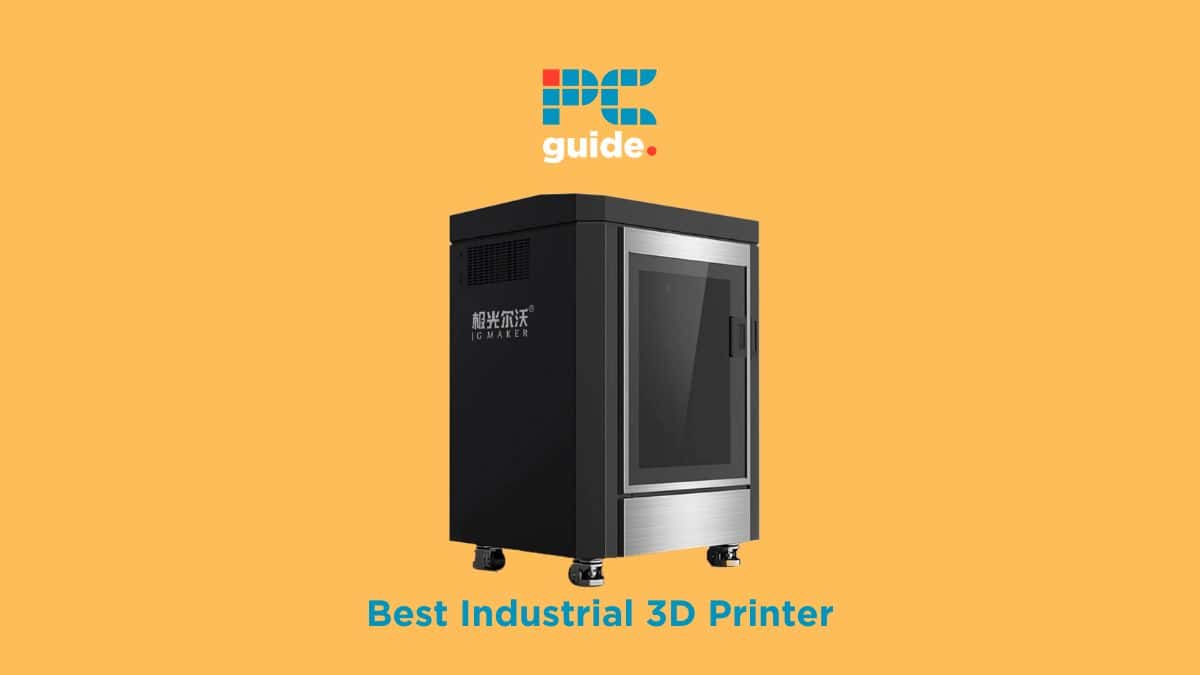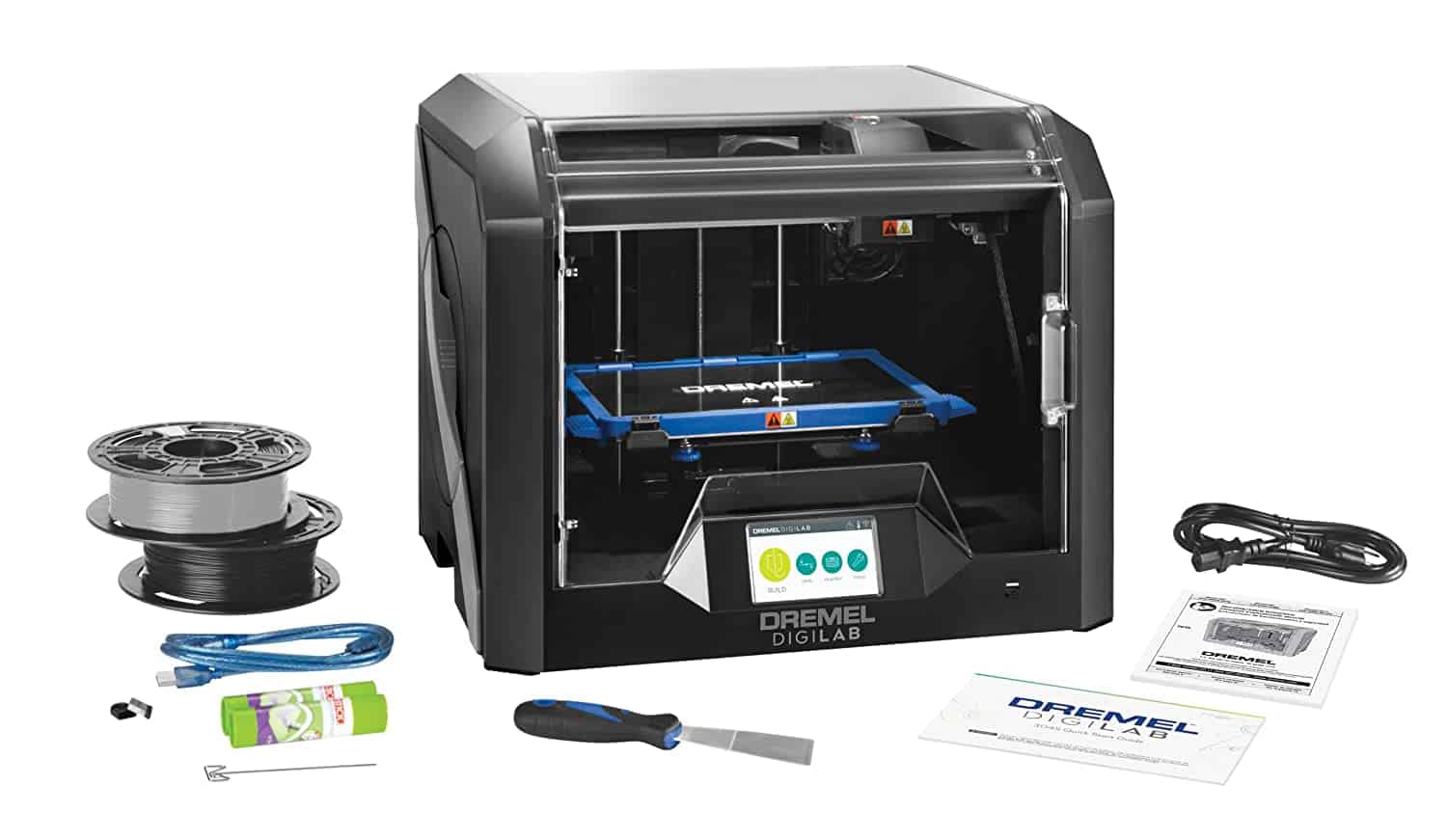Best Industrial 3D Printer: Top Picks for Manufacturing in 2025

Table of Contents
If you’ve found that the realm of consumer-grade 3D printers is somewhat lacking in quality, you may want to consider an investment into one of the best industrial 3D printer options on the market. Though they’re more expensive, these units offer professional-quality model rendering across a wide range of filaments. But if you’re looking to step up from a beginner 3D printer to a more advanced system for your business, it can be hard to know what the right one for you is.
To help, we’ve endeavored to pick a handful of top industrial 3D printer models. Factoring in a range of budgets and different industry niches, we’re sure to find the right 3D printer as befits your needs.
-
Editor’s Pick
JG MAKER A9 Pro
- Build Volume: 500mm x 400mm x 600mm
- Filament: PLA, ABS, PETG, TPU
- Connectivity Technology: USB
- Filetype: STL
-
Best Industrial 3D Printer for Different Filament
Raise3D Pro2 Plus
- Build Volume: 305mm x 305mm x 605mm
- Filament: PLA, PETG, ABS, PC, Wood, Nylon , TPU, PVA, Carbon Fiber, Metal
- Connectivity Technology: USB, WiFi Direct
- Filetype: STL
-
Best Budget Industrial 3D Printer
Dremel DigiLab 3D45 3D Printer
- Build Volume: 254mm x 152mm x 170 mm
- Filament: PLA, ABS, PETG, Nylon,
- Connectivity Technology: USB
- Filetype: GCode
-
Best Large Industrial 3D Printer
JG MAKER 800SE
- Build Volume: 800mm x 800mm x 500mm
- Filament: Silicone
- Connectivity Technology: USB, Ethernet
- Filetype: STL
How We Picked the Best Industrial 3D Printer
For top-shelf industrial 3D printing, you tend to need to make inquiries with a specific manufacturer for made-to-measure industrial 3D printers. For more readily available industrial 3D printers, there are top-end options available for purchase. We considered the various print properties of these: print speed, resolution, build volume, and filament compatibility. With this in mind, we considered the price-to-performance of each unit relative to one another.
We settled on four products, across a range of budget points and specialist needs. Though not every printer will fill every niche, we hope that at least one of our choices today will suit your print needs.

- Build Volume: 500mm x 400mm x 600mm
- Filament: PLA, ABS, PETG, TPU
- Connectivity Technology: USB
- Filetype: STL
An industrial-grade enclosed 3D printer, this unit is ideal for businesses who need ample versatility without impeding quality, for tremendous results.
- Large build volume – at 500mm x 400mm x 600mm, you have plenty of room for your prints.
- Detailed print resolution – the A9 Pro has precise multi-functional controls for high-resolution print results.
- Slower print speed – whilst not ultra-slow, the A9 Pro may not be fast enough for all industrial applications.
One of our favorite professional 3D printers, the JG MAKER A9 Pro is a top industrial-grade 3D printer. Capable of printing to large sizes and accommodating a wide range of filaments, this 3D printer adds tremendous value to any manufacturing process.
Boasting a respectable build volume of 500mm x 400mm x 600mm, this 3D printer accommodates a wide range of printing briefs for architects, engineers and anyone else wishing to create sterling 3D models. Detail isn't lost to scale, however, as the printer employs highly precise z-axis controls to maintain consistent accuracy from the magnetic printheads. With automatic leveling and compatibility with a wide range of filaments such as ABS, the A9 Pro adds tremendous value to any business.
What detracts value, however, is the print speed. Whilst not blisteringly slow, the A9 Pro isn’t fast enough for all applications, which can cause backlogs in the process. We still think it’s worth the cost, however, and highly recommend the A9 Pro.

- Build Volume: 305mm x 305mm x 605mm
- Filament: PLA, PETG, ABS, PC, Wood, Nylon , TPU, PVA, Carbon Fiber, Metal
- Connectivity Technology: USB, WiFi Direct
- Filetype: STL
For printing a wide range of filament in comfort, the Pro2 Plus is a sterling industrial-grade model.
- Highly filament-compatible – the dual extruder technology, along with a wide range of compatible filaments, gives you huge scope to create.
- Precise prints – the 32-point motion control board makes for highly accurate prints with the Pro2 Plus.
- Inconsistent software – the 3D printer’s driver software and wireless connectivity are both highly temperamental, which can be a huge issue for important prints.
If your production pipeline needs to print using a wide range of filament, consider the Raise3D Pro2 Plus: a sterling print solution from Raise3D. Capable of highly precise rendering of the most complex models, this 3D printer is ideal for varied industrial-grade printing.
With a huge range of compatible filaments, from olfactory favorites like PLA to more niche options like wood or carbon fiber, the Pro2 Plus is immensely versatile. Factor that in with dual extruders that allow for dynamic multi-filament designs or multi-color prints. With a build volume of 305mm x 305mm x 605mm, you’ve got ample space to allow your designs to come to fruition, and the 32-point control board ensures constant accuracy.
What’s less accurate, however, is the Pro2 Plus’ software. With inconsistent connection and poor functionality, it can be a struggle to set up more complex prints. Once you get going, the Pro2 Plus is a tremendous 3D printer for multiple filaments.

- Build Volume: 254mm x 152mm x 170 mm
- Filament: PLA, ABS, PETG, Nylon,
- Connectivity Technology: USB
- Filetype: GCode
Looking for an industrial-grade 3D printer under $2000? The DigiLab 3D45 is capable of stunning prints without breaking the company bank.
- Filament optimization – to spend less time calibrating and more time creating, the 3D45 comes with automated features to optimize printing.
- Automated features – with auto-leveling and an HD camera to observe progress, the 3D printer allows you to press print with confidence.
- Slower print speeds – like the A9 Pro, speed is sacrificed for quality.
With excellent productivity, an intuitive interface, and advanced printing technologies, the award-winning Dremel DigiLab 3D45 is another top industrial 3D printer with a more budget-friendly price point.
One of the standout features of this 3D printer is its built-in RFID reader which detects whatever filament you load into it and optimizes the printing settings accordingly – to guarantee intricate printing no matter what filament you choose. You can even observe this printing in-progress via the built-in HD camera. It also features a rigid glass bed that adheres to the models tightly until the printing cycle ends. With varied print filaments such as ABS and Nylon, there’s plenty to like about the 3D45.
Something we dislike, however, is the print speed: at 150mm/s, we’re somewhat underwhelmed by the tradeoff between quality and speed. It’s the cost of a budget model, so if it’s not a huge concern then we still highly recommend the 3D45.
- Build Volume: 800mm x 800mm x 500mm
- Filament: Silicone
- Connectivity Technology: USB, Ethernet
- Filetype: STL
Much more towards the higher-end of industrial 3D printing, the 800SE is an immense but worthwhile purchase.
- Immense build volume – at 800mm x 800mm x 500mm, you’ve plenty of room to create industrial-grade designs.
- High print resolution – with accuracy within 0.05mm, the 800SE is well worth the expense for precise prints.
- SLA printing – only compatible with resin, the 800SE may not be suited to every industry’s demand.
For the ceiling of quality on your industrial 3D printer, the JG MAKER 800SE is well worth its admittedly high price. Boasting a huge build volume, this incredible unit is a great large model for high-end 3D printing.
Boasting an 800mm x 800mm x 500mm build volume, you’ve ample room to create stunning 3D prints. An SLA printer, this uses laser-guided systems to create highly accurate prints within 0.05mm. The intuitive software automatically detects the correct settings for different resin types, and adjusts print settings accordingly – and other intelligent systems work to minimize rippling and warping. This printer is intelligent, efficient and industrial-grade.
However, be aware before buying that SLA printers are limited to specifically silicone-based filaments, meaning you have less versatility than other printers. JG MAKER offer plenty of options within that limit, however, and the 800SE is still a worthwhile 3D printer investment.
Features and Considerations
If you’re investing into an industrial 3D printer, here are some pointers on what to look for – and what to avoid.
Build Volume
Industrial 3D printer build volumes can swell to ludicrous sizes measured in meters rather than millimeters, which are overkill for most applications. For most, a more modest but large build volume compared to that of typical 3D printers is a more cost-effective option and still offers plenty of versatility. Consider the maximum size of the prints you are aiming for, and buy accordingly.
Print Speeds
A few factors determine the print speed of a 3D printer: the number of extruders, their acceleration, and even a slowly-heating bed can have drastic effects on print speeds. A quick tradeoff between quality and speed can be achieved by replacing the nozzle with a wider-diameter model, but that is never ideal. If you know you'll need quick turnover rates, it is best to invest in a high-speed 3D printer from the outset.
Filament Compatibility
Another factor to consider when shopping for a large 3D printer is material compatibility. In a sense, this is a simple step to overlook, but one that can hamper your printing plans if you find out a printer doesn't support your filament of choice before hitting the buy button. Most will handle PLA out of the box, while pricier options may extend compatibility to less popular materials such as carbon fiber. Some higher-end 3D printers can handle more abrasive materials like metal.
Why are more Industrial 3D Printers Closed-Frame?
We’ve chosen entirely enclosed 3D printers for our selection today, as most of the top-shelf industrial 3D printers are enclosed. There’s a number of factors that contribute to this, the primary one being safety. 3D printers heat up thermoplastics to high temperatures in order to extrude them, which emit fumes. Without a closed frame to help mitigate these fumes, these can spread in a work environment and cause serious damage. Especially in areas with other hazardous materials nearby, this can be a serious risk to workers. As such, it’s generally preferred to keep industrial 3D printers closed-frame – and the few open-frame models are always operated using protective gear.
FAQs
3D printer prices vary depending on the use case, with consumer-grade models available for as little as $200. For professional or business-grade 3D printing, however, we wouldn’t recommend a model below the $3,000 mark unless working to a serious budget constriction.
Yes: any business that involves design or visualization can benefit from a 3D printer. Architects, game designers, engineers – to name a few – all use 3D printing technology to manifest their work in a 3D model.
Verdict

- Build Volume: 500mm x 400mm x 600mm
- Filament: PLA, ABS, PETG, TPU
- Connectivity Technology: USB
- Filetype: STL
It may not be the fastest industrial 3D printer, but the JG MAKER A9 Pro sits at a healthy median of price, performance, quality and compatibility. We’re huge fans of this accommodating, intuitive and efficient 3D printer, and highly recommend it for industrial processes.
For some more affordable 3D printing solutions, check out our guide on the best 3D printers for small businesses.
